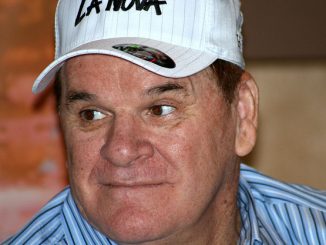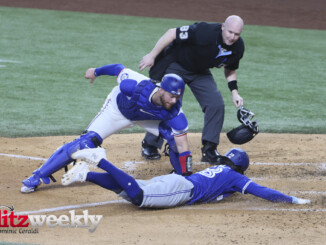
By Mark Miller
Admit it, Rangers fans, your favorite team’s June slump had you panicking and calling for wholesale changes which is the complete opposite of where the Texas executive team stands at the halfway point in the 2013 season.
Despite a six-game losing streak that cost them the top spot in the American League West division, the Rangers were not far behind the Oakland A’s and in the middle of the wild card hunt as of late June. That’s not too bad for a team that went into the offseason with eight free agents and started the year with a bunch of injured pitchers and plenty of question marks.
“We’re more or less where we hoped to be vying for first place in our division and vying for one of the wild cards,” said assistant general manager Thad Levine. “We knew we’re going to have a meaningful facelift and there would be a different complexity to the team especially on offense. We also made some investments in injured players.”
The investments were in Joakim Soria, the former closer for the Kansas City Royals, and holdover starters Colby Lewis and Neftali Feliz. The Rangers knew it would be at least midseason before Soria (Tommy John surgery rehabilitation) could contribute and even later for Lewis (right flexor pronator surgery rehab) and Feliz (Tommy John surgery rehab). What they didn’t expect were rookie Martin Perez (broken left wrist), and veterans Matt Harrison (inflamed nerve in lower back) and Alexi Ogando (right biceps tendinitis) going down in March, April and May, respectively.
Additional injuries to offensive regulars A.J. Pierzynski, Ian Kinsler and Mitch Moreland clearly hurt the offense. Thanks to strong months of April and May, the Rangers remain among the American League elite even while giving their fans heartburn they’d like to get rid of in the coming months.
The team has the same goal in mind but on a more patient and controlled level. With Levine’s help, here’s more assessment of where the Rangers have been and might be going the rest of this season.
Offense
When a team loses players like Josh Hamilton, Michael Young and Mike Napoli, there’s bound to be a dropoff in offensive production. That’s certainly been the case as the Rangers, who led the major leagues in average (.280) and runs scored (443) at the 2012 All-Star break, have collectively hit just .263 (eighth overall) with 319 runs (12th) through June 20.
But there’s been plenty of impressive numbers starting with always-steady third baseman Adrian Beltre (.304 average, 14 HRs, 39 RBI), catcher A.J. Pierzynski (.301, 6, 22), second baseman Ian Kinsler (.299, 7, 26), first baseman Mitch Moreland (.288, 12, 29), and right fielder Nelson Cruz (.265, 18, 50). Unfortunately Kinsler and Moreland missed considerable time with injuries, time that corresponded with the Rangers’ slump that saw them win just seven of 21 games from May 26 to June 18.
The problem as Levine sees it is when the Rangers hit well, everybody is hitting well but when they slump, they also do it together. That’s what’s happened in the three weeks after the team raced to a 32-17 record, the best first 49 games in team history.
Pitching
The multitude of injuries forced the Rangers to move rookies Nick Tepesch and Justin Grimm into their starting rotation and youngsters like Joe Ortiz, Tanner Scheppers, Michael Kirkman and Robbie Ross in key bullpen roles. The staff had a 3.76 earned run average as of June 20, compared with 3.78 at last year’s All-Star Game.
“Considering the volume of injuries we’ve had and to still be near the top of many pitching categories is remarkable,” Levine said.
Reason No. 1 is Yu Darvish, who clearly has become the staff starting ace with a 7-3 record and 2.84 ERA with 137 strikeouts in 101 innings. No. 2 is an improved bullpen anchored by closer Joe Nathan (1-0, 22 of 23 saves, 1.81 ERA), and Scheppers (5-0, 1.00) who has been an eight-inning specialist.
But perhaps the biggest explanation is veteran catcher Pierzynski. While Rangers fans may not have been very familiar with him, baseball people like Levine always knew his worth which is why they signed him to replace Napoli.
“He’s been a winner throughout his career,” Levine said. “If you look at all the teams he’s played with combined they are well above .500. While there may be some coincidence, I think he has had something to do with it.
“What he’s done with our pitchers has been even better than expected. He’s like a pitching coach on the field. With his skills helping our inexperienced pitchers he’s benefited us tremendously.”
Bench Much Improved
One of the main objectives entering 2013 was to improve on a bench that was virtually non-existent last year. Just to have enough versatility to allow the starters to rest would be good enough.
Consider that goal met so far thanks in major part to veteran Jeff Baker. In 37 games before going on the disabled list June 18, Baker hit .317 average with nine home runs. Though their numbers aren’t as good as Baker’s, veteran catcher Geovany Soto, rookie infielders Leury Garcia and Jurickson Profar, and outfield platooners Leonys Martin and Craig Gentry have played well enough to help.
“Unlike years past where we felt such a colossal dropoff from our starters to our bench players, the level of play this year has been very different,” Levine said.
The Future
As manager Ron Washington likes to tell, every team goes through slumps. Last year’s for the Rangers came at season’s end when they could do little about it. They hope this season’s only happens in June when there’s still plenty of time to assess the future.
So where would the Rangers turn if they decide they need help? With young players like Profar, Tepesch, Grimm, Scheppers and others already in the major leagues, there’s not really much immediately available in the minor league system.
“The next wave may be here already,” Levine said.
The good news is that young talent has been a major factor in keeping the team afloat. If they continue to improve, so will the Rangers.
With time still on their side, Levine said the Rangers are in no rush to make decisions as they analyze their needs over the next month before the July 31 trading deadline.
“We’re open for business and if the right things come up within the next month we’d certainly look at them but otherwise we’re in a position of evaluating the state of the union from both a health standpoint and performance standpoint,” he said.
“We built a team that we hoped would be competitive and as the season progressed we hoped we’d start getting our pitchers back in a wave without having to go through the trade route or free agent signings.”
Soria and Ogando are the closest to returning, most likely before the All-Star Break if not already. If all goes well, Lewis, Feliz and Harrison will pitch sometime this year.
The question remains will the Rangers play well enough to remain close enough to make a final push if they ever return to full strength?
“We feel we’ve been in the upper levels this year and the next line of defense is on the disabled list and getting healthier,” Levine said.




